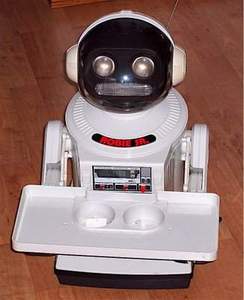
figure 1 |
| Aiee, Robot!
I came home to visit my family for the weekend and, as usual, we got up to some exciting activities. The project this time: revive my ancient Robie Sr. robot (figure 1) a relative of the Omnibot, a treasured toy from my childhood in the 1980's, and "modernize" him a bit.
Robie's troubles started about 17 years ago when his battery (a giant 6V lead-acid type) died. At the time, a replacement was prohibitively expensive (possibly because I was 12). But to my surprise, the model of battery they used still exists and my dad picked up a replacement this summer on a trip to the U.S. A few hours of charging, and Robie was back in action.
But as cool as a factory-standard Robie is, he's pretty limited by modern standards. At the time, it was cool: you could record a program onto a cassette tape (young'uns, see here and play it back, and he'd do what you programmed him to. The program was an extremely basic form of frequency shift keying where there was one frequency for each button on the remote control, and the sound would be emitted from the remote for as long as you held down the button or pulled the joystick in a particular direction.
|
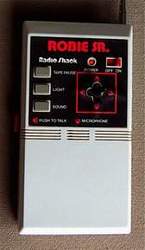
figure 2 |
From 1980's control...
I'd always been fascinated by the control system, because it was so easy to understand: (figure 2) the remote control would form the sounds it wanted to send, then modulate them to 49 MHz FM (the usual frequency used by consumer remote-control devices). The robot would receive the signal, demodulate it back to listenable sounds, then recognize the different frequencies. In the case of a tape program, it would simply skip the modulation/demodulation steps and process the sounds directly from the tape.
That remote control mechanism is still (very much to my dismay) exactly how most remote control devices work to this day. But the tape mechanism is officially outdated. You can't really expect me to reprogram my robot by recording an audiocassette, can you? I don't even have any audiocassettes. And how could I possibly connect that to the internet? Ridiculous.
But at the same time, I only have one 1980's robot (with high sentimental value) and one remote control, so I don't want to go fiddling inside either of them and risk ruining them. What to do? |

figure 3 |
...to 1990's control...
As it happened, from around the same time in my life, I had a set of two walkie-talkie devices that broadcast and received on the same frequency as Robie. (figure 3) You can imagine that I spent hours of my childhood listening to my robot control sounds coming through a walkie talkie, which is how I came to understand this stuff in the first place. The walkie talkies had a small amount of sentimental value, but weren't worth worrying about. So my dad disconnected the microphone and replaced it with an audio jack, thus allowing us to transmit whatever signal we wanted over the airwaves to control Robie. (Most of my hardware rewiring stories seem to end up with my dad soldering something. Apparently I'm lazy. Anyway, note the neat switch on the back that could re-enable the microphone, and how nicely the audio jack has been installed. Also note the newly-added clip on the side that allows you to lock in the transmit button.)
Round 1 of our upgrade was to bring the system firmly into the 90's.(figure 4) We downloaded a .wav recording of Robie's original demo tape (it's important to use plain .wav format, as mp3 compression risks disrupting the pure signal) and burned it to a CD. Ta da! No more need for the cassette player. |
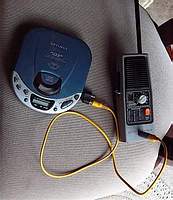
figure 4 |
...and into the 21st century (figure 6)And at last, the most exciting step: once you have a digital file and the ability to transmit from any audio equipment you want, the real answer is clear: computer control! While "watching" Bridge to Terabithia, I whipped up an application in Delphi in about an hour, (figure 5) thanks to the TJvWavePlayer component in the awesome open source JVCL library.
Success! After clicking the "Sound On" button, any sound from my computer can now be beamed into Robie, so I can have him move around and play astonishingly-low-fidelity MP3s at people! |
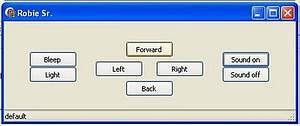
figure 5 |
Then my sister correctly pointed out that we could integrate something like Festival speech synthesis: enter a string into the UI, synthesize it, and send it to Robie's sound unit. A talking 1980's robot! Now that's an upgrade. |
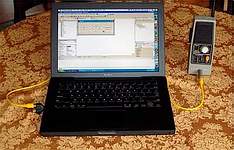
figure 6 |
...that is, until I get me a wireless webcam.Parting note I'm not crazy. You're crazy. October 6, 2007 20:34 |
For more Software and information, please check our Omnibot Programming Pages.
This information is brought to you through the Courtesy of  Please check their website for more detail information. Please check their website for more detail information.

Source: Avery Pennarun, Apenwarr - Updated 02-24-2009 |